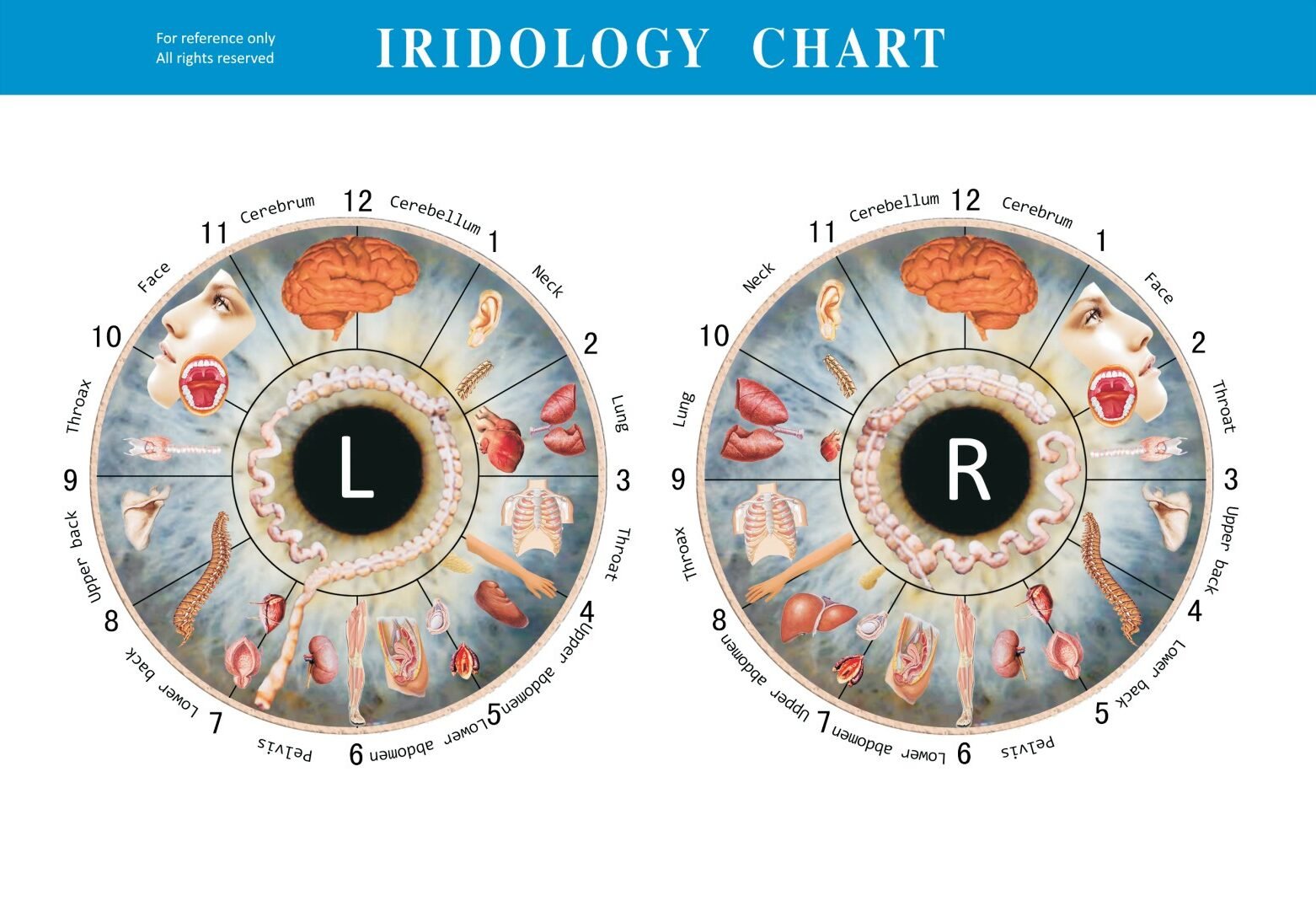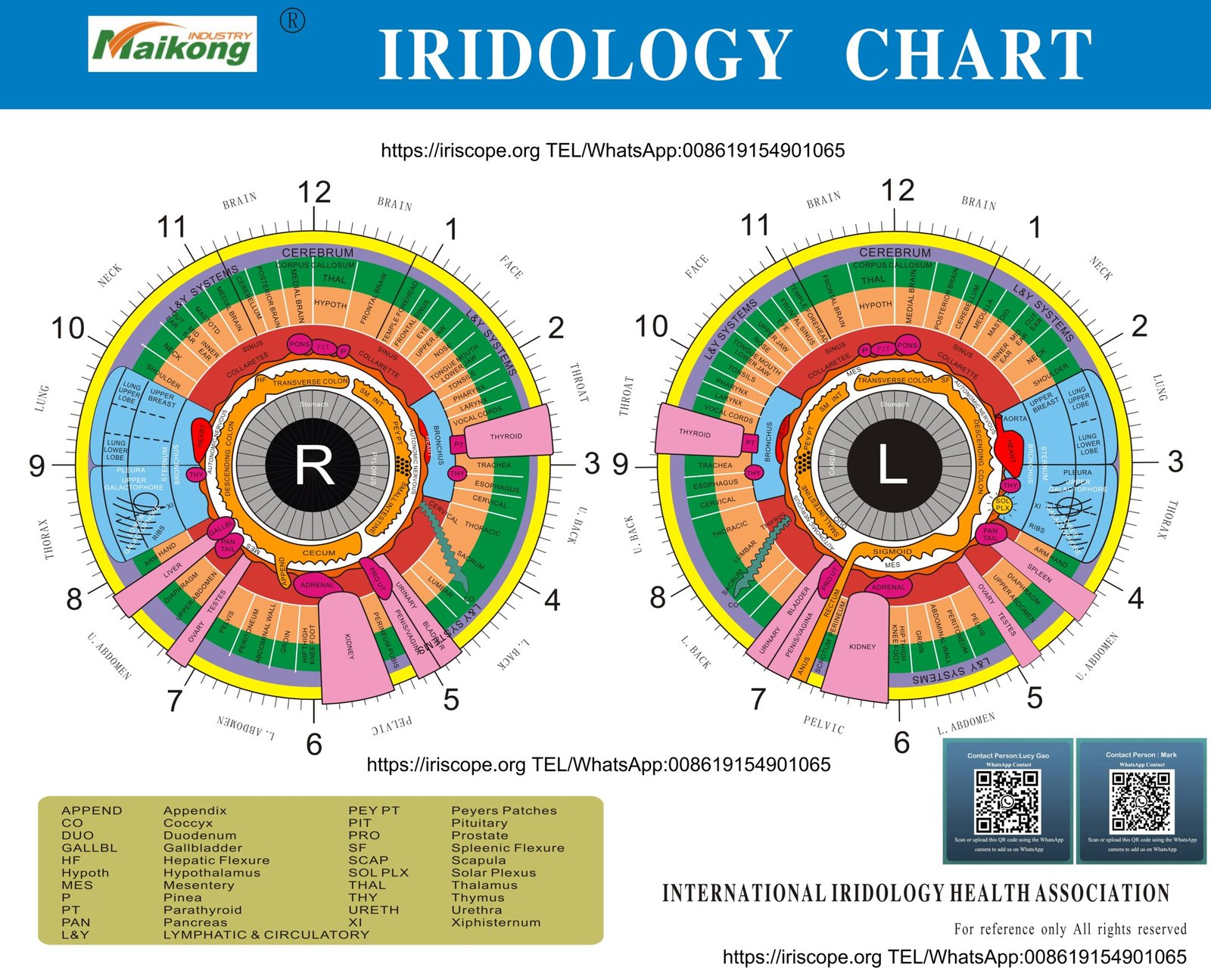The practice of iridology reading has fascinated holistic health enthusiasts for generations, yet remains surrounded by misconceptions and skepticism. As a window to our internal health, the iris contains remarkable information—but understanding what iridology can and cannot reveal is crucial. This comprehensive guide explores the most common myths about iridology, separating fact from fiction while highlighting the genuine value this practice offers when approached with proper understanding and professional equipment.
Standard iridology chart mapping body systems to iris zones. www.iriscope.org
Before addressing misconceptions, it’s important to understand what iridology reading actually entails. Iridology is the study of the iris (the colored part of the eye) to evaluate health conditions and potential weaknesses in the body. Practitioners analyze the structure, color, and markings in the iris to identify areas of inflammation, toxin accumulation, and constitutional strengths or weaknesses.
The iris is connected to every organ and tissue in our body through the nervous system and contains approximately 28,000 nerve endings. These connections potentially allow changes in body tissues to be reflected in the iris through nerve impulses. Professional iridologists use specialized equipment like iriscopes and high-resolution cameras to capture detailed images for analysis.
The practice dates back to the 1800s when Hungarian physician Ignatz von Peczely noticed changes in an owl’s iris after it suffered a broken leg. This observation led to the development of iridology as we know it today, with significant contributions from practitioners like Bernard Jensen, who created comprehensive iris charts mapping body systems to specific iris zones.
Myth 1: Iridology Reading Can Diagnose Specific Diseases
Professional iridologist using modern equipment for analysis, not diagnosis. www.iriscope.org
Perhaps the most persistent misconception about iridology reading is that it can diagnose specific diseases. This misunderstanding has led to both unrealistic expectations and unwarranted criticism.
What Iridology Reading Actually Reveals
Iridology does not diagnose specific diseases like diabetes, cancer, or heart disease. Instead, it reveals:
- Constitutional strengths and weaknesses
- Areas of inflammation or toxin accumulation
- Tissue changes and stress patterns
- Potential for certain health issues based on genetic predispositions
- Overall vitality and resilience of body systems
Professional iridologists understand these limitations and present their findings as indications of body conditions rather than medical diagnoses. They often recommend further medical testing when concerning patterns are observed.
Enhance Your Iridology Practice with Professional Equipment
Our professional-grade iriscopes and iridology cameras capture the detailed iris information needed for accurate analysis.
Explore Our Equipment
Myth 2: Iridology Reading Has No Scientific Basis
Research on iris tissue connections to body systems continues to evolve. www.iriscope.org
Critics often claim that iridology reading lacks scientific foundation. While it’s true that iridology hasn’t been fully validated by conventional medical research, this doesn’t mean it has no scientific basis whatsoever.
The Scientific Elements of Iridology
Several aspects of iridology are supported by scientific understanding:
- The iris contains thousands of nerve endings connected to the central nervous system
- The body’s autonomic nervous system influences iris appearance
- Research published in the IEEE Journal of Biomedical and Health Informatics (2013) showed correlations between pupil and collarette changes and certain digestive disorders
- Modern biometric analysis has brought greater precision to iris examination
- Ongoing research continues to explore these connections
While more research is needed, dismissing iridology entirely ignores the growing body of evidence suggesting connections between iris appearance and body conditions. Professional iridologists combine traditional knowledge with emerging research for a balanced approach.
Myth 3: All Iridology Reading Practices Are Equal
Professional equipment provides significantly more detail than basic tools. www.iriscope.org
A common misconception is that all iridology reading practices are created equal. In reality, there are significant differences in methodology, equipment quality, and practitioner training that dramatically impact results.
Factors That Differentiate Quality Iridology Practices
Professional Equipment
High-quality digital iriscopes and specialized cameras capture minute details invisible to the naked eye or basic magnifiers. These devices provide consistent lighting, proper magnification, and digital storage capabilities essential for accurate analysis.
Practitioner Training
Properly trained iridologists complete comprehensive education programs, often through accredited institutions like the International Iridology Practitioners Association (IIPA). They understand both the capabilities and limitations of iridology.
Analysis Methodology
Professional iridologists use standardized analysis methods rather than subjective interpretations. They follow established protocols for examining iris structure, color changes, and specific markings.
Ethical Practice
Reputable practitioners maintain ethical standards, avoiding disease diagnosis claims and working collaboratively with other healthcare providers when appropriate.
When evaluating iridology services, these quality factors should be considered to ensure you receive accurate, professional analysis.
Myth 4: The Iris Never Changes
Subtle iris changes can be documented over time with consistent imaging. www.iriscope.org
Some critics claim that the iris remains static throughout life, making iridology readings pointless. While it’s true that the basic structure and color of the iris are genetically determined and relatively stable, this doesn’t mean the iris never exhibits changes.
Understanding Iris Changes
Professional iridologists recognize several types of changes that can occur in the iris:
- Acute inflammatory signs may appear as white markings that can change as inflammation resolves
- Pigmentation changes can occur with certain metabolic shifts
- Stress and toxicity patterns may alter subtle aspects of iris appearance
- The pupillary zone can show changes related to autonomic nervous system function
- Healing signs may appear as previously dark areas lighten
These changes are typically subtle and require professional equipment to document properly. The basic genetic iris pattern remains consistent, which is why iris scans work for biometric identification, but this doesn’t preclude the possibility of meaningful tissue changes that reflect health status.
Why Iridology Reading Equipment Matters
Documenting these subtle changes requires specialized equipment that provides consistent lighting, proper magnification, and precise image comparison capabilities. Consumer-grade cameras or basic magnifiers simply cannot capture the level of detail necessary for professional analysis.
Myth 5: Iridology Reading Is Only About Eye Color
Professional iridology examines numerous factors beyond basic color. www.iriscope.org
A common misconception is that iridology reading simply involves looking at eye color to make health determinations. This oversimplification misrepresents the complexity of professional iridology analysis.
The Multiple Dimensions of Iris Analysis
Professional iridologists examine numerous factors beyond basic color:
Iris Fiber Structure
The arrangement, density, and integrity of iris fibers provide information about constitutional strength and potential genetic predispositions.
Lacunae and Lesions
These are openings or separations in the iris fibers that may indicate areas of weakened tissue or potential health concerns in corresponding body systems.
Pigmentation Patterns
Specific pigment deposits and their locations can indicate metabolic activity, toxin accumulation, or healing processes.
Pupil Characteristics
The size, shape, and response of the pupil provide information about autonomic nervous system function and potential stress patterns.
Nerve Rings
Circular contraction rings in the iris may indicate stress responses and nervous system tension.
Collarette Integrity
The autonomic nerve wreath (collarette) divides the iris into digestive and circulatory zones, with its appearance providing insights into digestive function.
Professional iridology integrates all these factors for a comprehensive analysis that goes far beyond simple color observation. This complex assessment requires both specialized training and professional equipment.
Upgrade Your Iridology Practice
Our professional iridology software helps practitioners analyze all aspects of iris structure with precision.
Explore Iridology Software
Myth 6: Iridology Reading Replaces Medical Care
Professional iridologists work collaboratively with medical practitioners. www.iriscope.org
Some critics suggest that iridology practitioners position their services as replacements for conventional medical care. This is a serious misconception that ethical iridologists actively work to correct.
The Complementary Role of Iridology Reading
Professional iridology is best understood as a complementary assessment tool that works alongside, not in place of, conventional medical care:
- Iridology can identify potential areas of weakness before symptoms develop, allowing for preventive measures
- It provides insights into constitutional tendencies that may inform lifestyle and nutritional choices
- Iridology can suggest areas that may benefit from further medical investigation
- It offers a holistic perspective that complements the symptom-focused approach of conventional medicine
- Ethical practitioners refer clients to medical doctors when concerning patterns are observed
Ethical Practice Guidelines
Reputable iridology organizations emphasize these important ethical guidelines:
- Never diagnose specific diseases through iridology alone
- Always recommend appropriate medical testing when potential health concerns are identified
- Present findings as constitutional assessments rather than medical diagnoses
- Maintain open communication with clients’ healthcare providers when possible
- Stay within the scope of practice as a complementary assessment method
When practiced ethically, iridology serves as one component of a comprehensive health approach that includes conventional medical care, appropriate testing, and lifestyle modifications.
Myth 7: Iridology Reading Results Are Purely Subjective
Modern iridology software provides standardized analysis parameters. www.iriscope.org
Critics often claim that iridology reading results are entirely subjective and vary widely between practitioners. While interpretation differences exist (as they do in many health assessment methods), modern iridology has developed increasingly standardized approaches.
Standardization in Modern Iridology
Several developments have enhanced objectivity in professional iridology:
- Standardized iris charts with consistent zone mappings
- Digital imaging technology that provides consistent lighting and magnification
- Computer-aided analysis software with objective measurement tools
- Established protocols for identifying specific iris signs
- Certification programs that ensure consistent training standards
The Role of Technology in Objective Analysis
Modern iridology equipment and software have significantly improved analytical consistency:
Digital Iriscopes
Professional digital iriscopes provide consistent lighting, magnification, and image quality, eliminating many variables that previously led to subjective differences.
Analysis Software
Specialized software can measure iris features with precision, apply standardized analysis parameters, and even use artificial intelligence to identify patterns consistently.
While professional judgment still plays a role in interpretation (as it does in reading X-rays, blood tests, and other medical assessments), these technological advances have significantly increased the objectivity and consistency of iridology analysis.
Request a Professional Iridology Consultation
Experience the benefits of a standardized, professional iridology reading with our certified practitioners.
Schedule a Consultation
Embracing the True Value of Professional Iridology Reading
Professional iridology combines advanced technology with personalized consultation. www.iriscope.org
When separated from misconceptions and approached with proper understanding, iridology reading offers valuable insights as part of a holistic health assessment. By recognizing both its capabilities and limitations, individuals can benefit from this fascinating practice while maintaining realistic expectations.
Professional iridology, conducted with high-quality equipment and by properly trained practitioners, provides a unique perspective on constitutional strengths, potential weaknesses, and overall vitality. This information can guide preventive health strategies, lifestyle modifications, and areas for further medical investigation when appropriate.
As research continues and technology advances, the practice of iridology continues to evolve, becoming increasingly standardized and objective. By embracing these advancements while respecting traditional knowledge, the field moves forward as a valuable complementary assessment method.
Whether you’re a health practitioner interested in adding iridology to your practice or an individual curious about what your iris might reveal, approaching this field with an educated, balanced perspective allows you to appreciate its genuine value while avoiding the pitfalls of misconception.
























